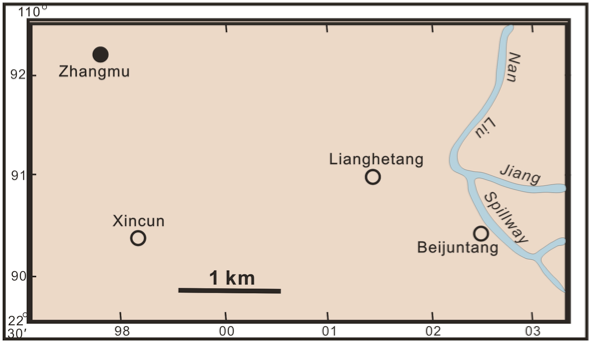Beijuntang Fm
Type Locality and Naming
The type section is located along western side of Nanliujiang Spillway nearby Beijuntang village, about 3 km east of Zhangmu Town, 35 km southeast of Yulin City. It was proposed by Shi W.J. of Guangxi Regional Geological Survey in 1980.
[Figure: Map showing the locations of the Beijuntan Fm, Lianghetang Fm and Zhangmu Fm in the Yulin area of Guangxi]
Lithology and Thickness
Sandy claystone. The Formation is mainly composed of gray-black mudstone, in which a 1 m thick sandstone lens is intercalated within the lower part; limestone lenses and concretions in the middle and locally rich in medium-thick bedded sandstone in the upper. In the basal part it comprises up to 41.8 m yellow sandstone with mudstone succession, in which wave and cross bedding occurred. The weathered surface of mudstone are gray, gray-white, purpled red and yellow green in color. Due to the incomplete exposure of the formation and the fault and fold occurrence the thickness is estimated more than hundreds meters.
Relationships and Distribution
Lower contact
Conformable contact with the underlying Silurian Fangcheng Gr
Upper contact
Unclear contact with the overlying Lianghetang Fm.
Regional extent
With restricted distribution the formation is only seen in the Yulin area spreading from northeast to southwest
GeoJSON
Fossils
The fossils of the formation is characterized by the graptolites and dacryoconarids, including Monograptus praehercynicus, M. hercynicus, M. microdon, M. aequabilis, and Paranowakia sp. Four brachiopod assemblages were recognized, from bottom to up: the Quadrithyrina expansa-Prodavidsonia mirabilis, the Grayina magnifica guangxiensis, the Grayina magnifica sinica and the Quadrithyrina robusta-Boucotia Assemblages. The species Carinatina prolowtherensis, Reticulatrypa bella, Gypidula kayseri, Spirigerina supramarginalis, Vagrania yangi, Isorthis sp., Hedeina sinensis, Atrypa elliptica are common seen in the formations (Wang and Yang, 1994).
Age
Depositional setting
The graptolites and dacryoconarids are indicator of deep marine basin and the associated brachiopod communities have been reported as being in relatively offshore, deep-water environment in Yukon of Canada, Nevada of USA, Ural of Russia, Podolia of Poland and New South Welsh of Australia
Additional Information
